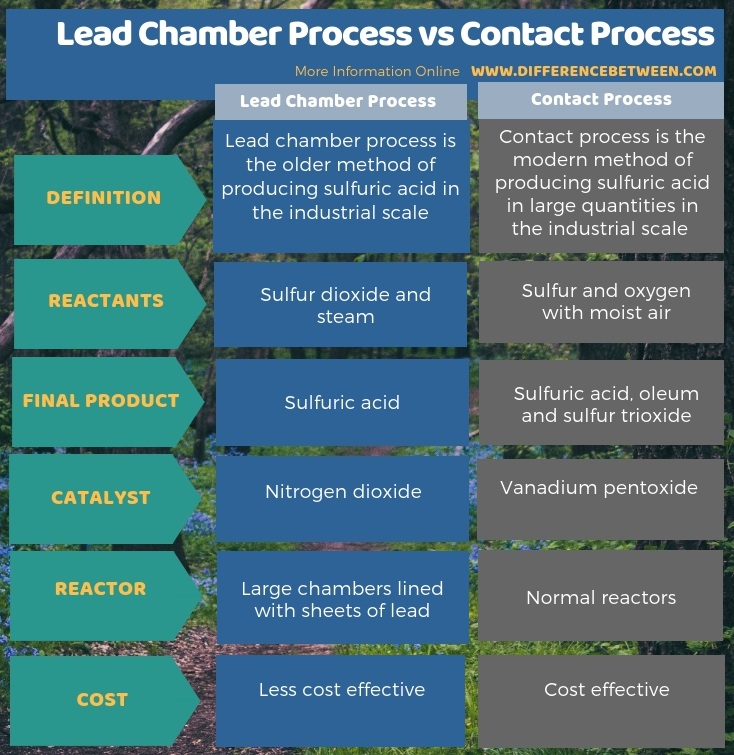Difference Between Lead Chamber Process and Contact Process
Table of Contents
The key difference between lead chamber process and contact process is that the lead chamber process uses gaseous nitrogen oxides as a catalyst, whereas the contact process uses vanadium pentoxide.
Lead chamber process and contact process are important industrial processes we use for the production of sulfuric acid in large scale. However, the lead chamber process is the old method, and it has now largely been replaced by the contact process. It is because the contact process is more economical and uses less expensive catalysts; not only that, this process produces sulfur trioxide and oleum as well.
CONTENTS
1. Overview and Key Difference
2. What is a Lead Chamber Process
3. What is a Contact Process
5. Side by Side Comparison – Lead Chamber Process vs Contact Process in Tabular Form
6. Summary
What is a Lead Chamber Process?
Lead chamber process is the older method of producing sulfuric acid in the industrial scale. However, it still meets about 25% of the current sulfuric acid production. Nevertheless, this method is not very popular at present because of the high production cost compared to the final outcome.

Figure 01: Production of Sulfuric Acid by Different Countries
Further, this process uses gaseous nitrogen oxide as the catalyst. In the process, we need to introduce sulfur dioxide into large chambers along with steam and nitrogen dioxide. These large chambers are lined with sheets of lead. Inside the chambers, there is a system which sprays the gases along with water and camber acid. Generally, the chamber acid we use is 70% sulfuric acid. We then need to let the sulfur dioxide and nitrogen dioxide dissolve in water for 30 minutes. Nitrogen dioxide speeds up the reaction but is not consumed during the progression of the reaction. In this chamber, sulfur dioxide oxidizes into sulfuric acid. However, this process is highly exothermic and releases high heat energy.
The contact process is the modern method of producing sulfuric acid in large quantities in the industrial scale. Also, this method produces sulfuric acid in high concentration. Earlier, people used platinum as the catalyst for the reaction, but due to high cost, we now use vanadium pentoxide. The importance of this process is that it produces sulfur trioxide and oleum as well, and the process is very cost-effective.
In the process, the first step includes the combination sulfur with oxygen to form sulfur dioxide. Then we need to purify the produced sulfur dioxide from a purifying unit. Next, we have to add an excess of oxygen to this sulfur dioxide in the presence of vanadium pentoxide catalyst. This step forms sulfur trioxide. Then this sulfur trioxide is added to sulfuric acid. It gives oleum, which is disulfuric acid. The final step is adding oleum into the water, which gives sulfuric acid in a very concentrated form.
There are two major processes we use for sulfuric acid production: lead chamber process and contact process. The key difference between lead chamber process and contact process is that the lead chamber process uses gaseous nitrogen oxides as a catalyst, whereas the contact process uses vanadium pentoxide. Furthermore, the reactants for the lead chamber process are sulfur trioxide and steam while the reactants for the contact process are sulfur, oxygen and moist air. Moreover, the final product of the lead chamber process is sulfuric acid, but the contact process produces sulfur trioxide and oleum as well. So, this is also a difference between lead chamber process and contact process.

Summary – Lead Chamber Process vs Contact Process
There are two major processes for sulfuric acid production: lead chamber process and contact process. The key difference between lead chamber process and contact process is that the lead chamber process uses gaseous nitrogen oxides as a catalyst, whereas the contact process uses vanadium pentoxide.
Reference:
1. “Chamber Process.” Encyclopædia Britannica, Encyclopædia Britannica, Inc., Available here.
Image Courtesy:
1. “Diagram Production sulfuric acid en” By Orci – own work, source: United Nations Statistics Division (Public Domain) via Commons Wikimedia
ncG1vNJzZmivp6x7pbXFn5yrnZ6YsqOx07CcnqZemLyue8OinZ%2Bdopq7pLGMm5ytr5Wau264xJqbZpuYlrqjsdFmp6unk5rAtHnAp5tmm5%2BjwaKv02anq6eTmsC0ew%3D%3D